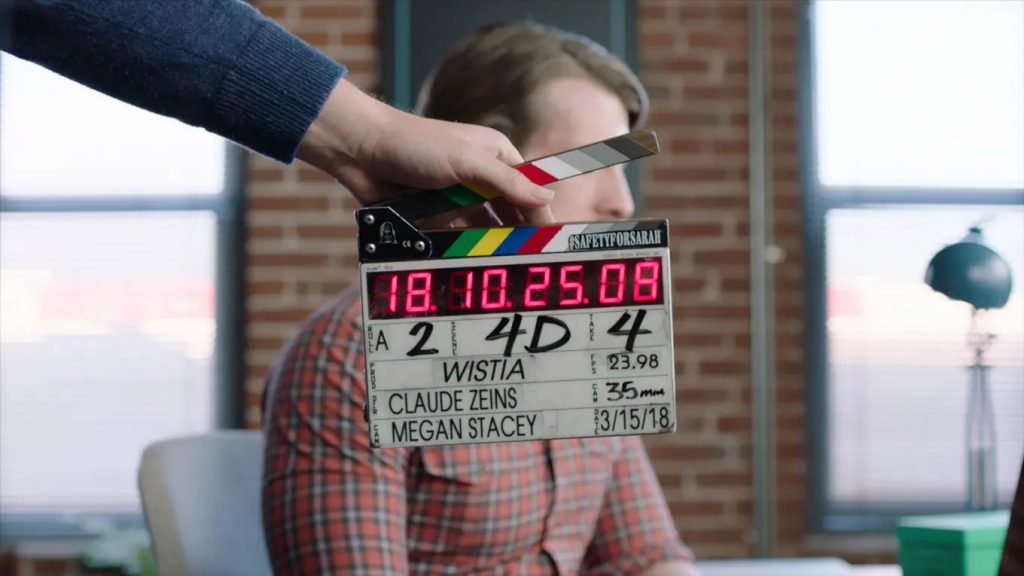We are back in full swing with the school year and super excited to dive back in. Today’s blog post discusses ways to help your team feel comfortable on camera.
Here are some tips for helping your staff members get comfortable on camera.
1. Be okay with the process
When it comes to being in front of a camera, practice makes perfect. To get good at something, you just have to do it. Think about the things you’ve done in work or your personal life. The first time around you might feel awkward and struggle a bit, but with time and experience it gets easier.
Oftentimes, when a school marketing team hires a videographer, everyone gets excited. Then they view the first few videos and they aren’t as great as expected. Remember those are the first videos you’re making and they will get better. Just embrace the process and know you’re going to get better. Embrace the messy!
If your first videos aren’t perfect, it’s okay. The best way to build trust and relationships is to be human.
2. Invite team members to write their own scripts
People that don’t write their own scripts struggle more. If you think about it, they are the expert on what they’re talking about. You can help them by providing a framework for a script and giving them assistance, but it’s best to have them involved in the content of the video.
3. Help the person that will be on camera communicate effectively
Even if the staff member wrote their own script, they often struggle with effectively communicating on camera. Here’s how you can help them overcome this challenge.
- Explain to the team member what an effective structured video looks like. Help them envision what the final product is going to look like. Train them on the best practices for video production (principle-based practices, not personal attributes.)
- Remember you are teaching principles of communication, not teaching them to be a different person.
- You can’t expect people to just “know” how to perform on camera. They need support and validation to feel confident and express themselves on camera.
- It also helps when staff members have see the result of a video that was done well. This gives them something to relate to. This is also why it’s important to share success stories early on.
- Ask the staff member to get familiar with the script, but not to memorize it word-for-word. Dialog tends to come out stiff or sound like the person is speaking in monotone if they try to recite from memory. Encourage them to get comfortable with their talking points so they are able to speak naturally during filming, but still cover the critical content.
- Divide the script into sections about two to five sentences long. This way, they won’t struggle to remember long paragraphs.
- Encourage the person to take it slow. Most people tend to speed up when they are nervous. Aim to speak a little slower than usual and it should come out perfect!
- Don’t go for perfect. If the person goes off-script a bit have them keep going instead of stopping and making the “uh-oh” face. The audience will never know there was a mistake!
- If you have any language related to brand messaging for your school you want the person on camera to include, be sure to discuss that ahead of time.
4. Coach the person that will be on camera about their image
Most people don’t know what to do to present their best image on camera. Coach them to help them feel more comfortable.
- Encourage them to wear an outfit they feel comfortable in and looks put-together. Anything tailored, clean and wrinkle-free is a great start.
- Do not over- or under-utilize makeup. Let the person check out how they will look in different lighting to help them determine how much makeup to use.
- Place a mirror a few feet behind the camera and encourage the staff member to check in periodically on their posture and body language. You can also encourage the person on camera to speak to their reflection like they are another person. Keep in mind this may not work with everyone – it may prove too distracting for some people. Try this tactic but keep in mind it might do more harm than good.
- Help the person become aware of any nervous tics they may have. Encourage the person to take deep breaths and relax their shoulders to pull out of these bad habits. Nervous tics may include:
- Incessantly clearing their throat
- Scrunching or wrinkling their eyebrows
- Wringing their hands
- Cracking their knuckles, elbows or other joints
- Tapping their foot
- Shifting back and forth or swaying
- Blinking excessively
- Swallowing hard
- Saying “um”, “uh”, or “like” too often
- Tensing their body.
- Suggest they do whatever makes them relax immediately before filming. This could be exercising, yoga, meditating, eating their favorite snack, singing at the top of their lungs (maybe do this one in the car), etc. You get the idea!
- If the person is feeling a little low in energy, encourage them to drink a cup of coffee to give them a little “pep” in their voice.
- Have the person wear an outfit that will conceal sweat stains in case the lights (and nerves) cause them to perspire. Have them blot their face with tissues in between takes and have neutral powder on hand to avoid shine.
- Be open to letting the team member’s personality shine through in content.
5. Give the person on camera support during production
- Start out by asking the person being filmed to speak about anything they are passionate about to warm up and turn on their “speaker” personality.
- Keep them hydrated by providing water or hot tea between takes. Their parched throat could ruin an otherwise great take!
- Schedule plenty of time to film as many takes as necessary. You don’t want the person on camera to feel rushed.
- If the person (or people) on camera will need to walk, run or dance during the video, place markers on the floor so they know exactly where to stop before they go out of the frame. This can also help them remember a complex series of movements.
- Limit all distractions, including unnecessary people on the set or in the person on camera’s field of view.
- If they get shaky or tend to shift back and forth while talking, consider sitting in front of the camera instead of standing.
- Have someone hold up poster boards with bullet points to help the person on camera stay on message. You can also use an iPad app for this.
- Encourage the person on camera to do a relaxation exercise before going on camera. Take five minutes for them to relax each body part section by section. Have them start at the top of their head, down to their eyebrows, their stomach, etc., all the way down to their toes.
- Have the person on camera do a few push-ups or jumping jacks to get their heart rate up and blood flowing just before filming.
I hope these ways to help your team feel comfortable behind the camera help you create better, more engaging videos for your school. Just remember that being confident in front of the camera takes practice. Remind your staff members to not compare themselves to evening news anchors and primetime television actors and actresses. Help them to not feel discouraged if their first on-screen appearance isn’t worthy of an Oscar nomination because, after all their performance just needs to portray themselves, not win an award. Encourage them to have fun and be authentic.
Click here to read the original article posted by Brendan Schneider on SchneiderB Media on Oct 30, 2019.



![[PODCAST] Effective Event Marketing](https://www.schoolhouse.agency/wp-content/uploads/2021/08/PODCAST-Why-Marketers-Fear-Video.jpg)


